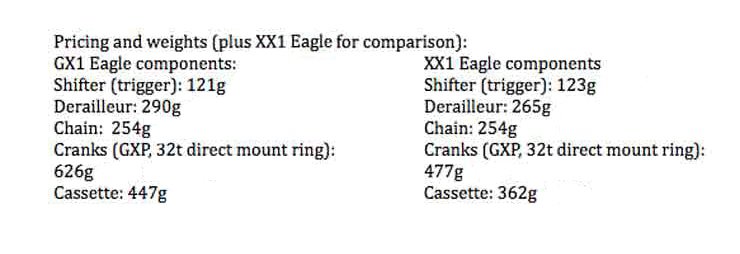GX1 Eagle brings along familar SRAM refinements, including improved wide/narrow tooth profiles on the second generation X-Sync2 chainrings, which are said to enhance chain retention while simultaneously reducing friction and allowing better clearing of grit. Eagle drivetrains also feature a stronger chain with rounder edges on the inner plates to smooth shifting, and a refined master-link (called Flowlink).
Rear derailleurs get some tweaks as well: Upper pulleys are offset to help guide the chain during shifts, and new shapes quiet things down while riding. The roller clutch mechanism was updated to be smoother and provide similar feedback regardless of gearing, and the CageLock button— which allows the derailleur cage to be held in place for easy wheel changes— has been relocated to make it easier to use.
Lastly, the cassette saw updates to tooth shapes (X-glide2) for better chain retention and smoother, quieter shifts across single and multiple cogs. You might be noticing a theme with Eagle: wider ranges, smoother shifting and better chain retention— and from the groups we’ve tested over the last year and a half, it works.

To keep prices low on the GX1 Eagle, you’ll find changes in materials and manufacturing techniques. For example, XX1’s carbon derailleur cages become steel and aluminum in GX1. And while XX1 Eagle’s cassette is actually one piece of intricately-machined steel (topped by an aluminum 50t cog), GX1 Eagle’s XD driver-compatible cassette utilises stamped steel cogs (and an alloy 50t) held together with stainless steel pins: a heavier, but less-expensive design.
The crank is another big difference between the groups. Available for both BB/PressFit30 and GXP bottom brackets, the forged 7000-series aluminum arms come with stamped alloy, direct-mount chainrings. These are available in a variety of sizes and cranks are compatible with any SRAM direct-mount ring. To compare, XX1 and XO1 Eagle cranks are carbonfibre, and the rings are forged and machined.
Luckily, all of SRAM’s Eagle components are cross-compatible. That means if you shag an Eagle cassette or derailleur and your shop only has XO1 in stock, you can be back up and running with whatever’s available. You can also pick and choose where you want to invest.
Weight-wise, GX1 Eagle stacks up well to the more expensive groups. We weighed both XX1 and GX1 Eagle groups to get a comparison and, unsurprisingly, the biggest difference was at the cranks. Pricing not yet available for South African market.






